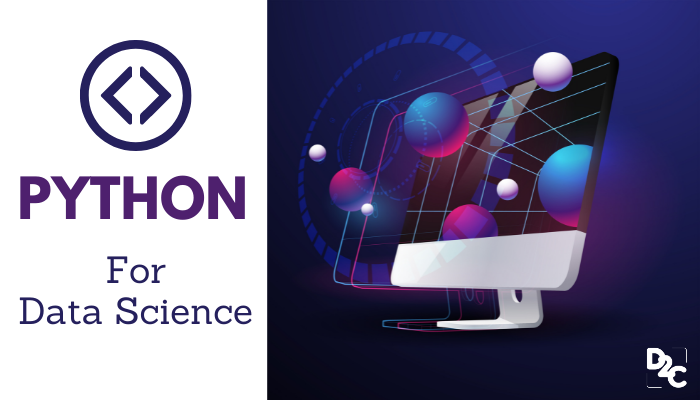- Why Python?
- Stage I: Mastering the Basics
- Stage II: Learning Python for Data Analytics
- Stage III: Developing the concepts of Python in Statistics and Math
- Stage IV: Mastering Python for Machine Learning
- The recommended course of action
Learn Python for Data Science in 4 Easy Steps

Python is the most preferred programming language amongst the developer's community when it comes to data science and machine learning, and why wouldn't it be? Python is an object-oriented, high-level language that makes coding very easy because the language emphasizes readability.
Five years ago it left the R programming language behind on Kaggle- which is the premier platform for all data science-related contests. Then in 2017, it got ahead of R on KDNuggets' yearly survey of data scientists' most utilized apparatuses. Then the year after, two-third of data scientists reported employing Python to use every day, thus making it the main language for data analytics experts.
With Python getting more popular-owing to its user-friendly data structures, simplified syntax, extensive support libraries, and evergreen presence of third-party modules, along with a host of other benefits-Data science specialists anticipate that this trend should proceed with expanding advancement in the Python ecosystem.
Learning Python on your own can be quite overwhelming to follow systematically sometimes. Though there are numerous wonderful online free courses and materials to learn Python for Data Science- knowing if you are on the correct path to dominate this fundamental expertise for data science can be quite tricky, How? Python has applications in areas that don't have much relation with data science, such as web and game development.
Hence, it becomes imperative to confirm if you are learning the Python nuances necessary for machine learning and data sciences or not, and this is where this article comes to your rescue!
Why Python?
1) It’s Free: The best part about using Python is that it doesn’t cost anything at all. You just need to download the software from their official website and start working on projects. There are no additional fees involved. This means that anyone who wants to get started with Python will find it extremely affordable.
2) Easy to Learn: If you want to become proficient in any field, then you must first understand how things work before moving forward. In the case of Python, it is pretty simple to grasp the basics. Once you know what each line does, you can easily move onto advanced concepts. Moreover, the documentation available online helps beginners to quickly master the basic concepts.
3) Extensive Support Libraries: One thing that sets apart Python from other languages is the fact that it offers a lot of built-in functions and tools that make life easier for developers. These include NumPy, Pandas, Matplotlib, SciPy, etc. All these packages help programmers perform various tasks faster than they would otherwise do so.
They also provide an excellent set of APIs, which allow users to interact with them through different methods like reading/writing files, manipulating arrays, plotting graphs, etc.
4) Highly Versatile Language: Another reason why people love Python is its versatility. As mentioned earlier, it supports many fields including web application development, scientific computing, artificial intelligence, machine learning, natural language processing, graphics design, video games, robotics, finance, cryptography, bioinformatics, etc.
Now without wasting any more time, let's dive into the 4 stages of learning Python for data sciences so that you can decide which stage you are currently on and proceed accordingly!
Stage I: Mastering the Basics
The first stage is for those who are currently starting with developing the foundations of the Python language. So, not only data scientists, but whosoever wishes to enter the world of Python in the right manner should keep in mind all the details mentioned in this section.
At the beginners level, you ought to essentially know fundamental ideas, for example, data types, variables, and certain basic introductory programs.
This includes understanding the syntax, operators, control flow statements, loops, conditionals, exceptions, modules, classes, objects, lists, dictionaries, tuples, strings, numbers, file handling, input/output operations, debugging techniques, etc. You should have the ability to use control flow tools- such as the if/else statements, Boolean operations, and different types of loops that are for, while, and nested loops.
How to properly learn python basics?
- One significant thing for hopeful data scientists at this level is to begin getting to know Jupyter Notebook. Jupyter is easy-to-use interactive data science and one of the best Python IDEs supporting numerical simulation, data cleanup, machine learning, data visualization, and statistical modeling.
- It is also known as Data scientists' computational note pad of choice since it permits the users to build equations, visualizations, and text along with codes. It's an amazing IDE for beginners to start working on while learning Python!
- You can master stage one if you solve problems that involve control flow and loops. Apart from this, simple games like Hangman and Quiz Game would help if you solved them. You can refer to various dedicated coding sites like GeekforGeeks to get and solve problems based on these topics.
- While solving coding problems, always begin by dry-running your code on paper for various use cases. Develop a proper logic as per the concepts, write down a basic algorithm, dry-run the various cases, and then begin the final coding and compilation.
Stage II: Learning Python for Data Analytics
Okay, so once you are well-versed with all the essential basics in Python for Data Science, you then reach stage II, and it mainly focuses on you to know all about the various libraries frequently used for data analysis, such as Pandas, NumPy, Matplotlib, and Seaborn. Common data science tasks such as data cleaning, exploratory data analysis, and feature engineering can be solved with those libraries.
How to master Stage II?
- Well, there are many ways to achieve this goal. One way is to read books or articles related to each library. Another method is to practice using the respective libraries through online tutorials. The third option is to work on real projects where you need to apply the same skill set.
- For instance, let us say you want to develop a web application that requires some sort of data analytics. In order to accomplish this task, you will require knowledge of Pandas, NumPy, Matplotlib, Seaborn, Scikit-learn, Sklearn, Statsmodels, and other relevant packages. So, you must first understand what they actually mean before going further.
Also, ensure that you're acquainted with most functions that are used in Pandas and Numpy. Some of them are list comprehension, lambda, zip(), f-string, and the with the statement.
Once you are done with reading up on the above-mentioned libraries, you can now move onto the third stage of learning Python for Data Science!
Stage III: Developing the concepts of Python in Statistics and Math
Now, from the last cleared stage you already are trained in cleaning data and conducting EDA, yet additionally, you should know every one of the key measurements, statistics, and math behind data science.
It's important to make sure the data you are using is not skewed, and that is where the role of Statistics come into play. If you use Matplotlib and Seaborn to plot histograms and boxplots, you'll be able to identify outliers. You need to know how to apply most statistical concepts to a data science project in Python. How to deal with skewed data, segment train/test data, and formulate a problem and hypothesis are some examples.
Functions and Algebra of Matrices are some of the important topics that you must know in Math because all these concepts would be carried out in Python through NumPy. This library has support for huge, multi-dimensional arrays and matrices, alongside an enormous assortment of significant level numerical capacities to work on these exhibits.
Another significant thing you ought to comprehend is the functioning behind Machine Learning algorithms. There's a ton of math and statistics behind those calculations and programs, so ensure you build a deep knowledge of them prior to learning the Python code that allows you to fabricate them.
Important Topics:
- Imbalanced data
- Segment train/test data
- Machine learning algorithms
- Arrays/matrices, and data visualization using Matplotlib/Seaborn.
Above all, knowing how to apply topics of statistics and math to a data science project in Python is the most significant part.
How to gain proficiency in this level?
Practice is the key to solving data science projects in Python- read about various such projects, formulate an approach, and work on the algorithms. Some of the key projects are sentiment analysis, credit card fraud detection, house-price trend analysis, and customer churn prediction.
Stage IV: Mastering Python for Machine Learning
Now comes the most exciting part - learning Python for Machine Learning (ML ). This involves understanding deep neural networks, reinforcement learning, generative adversarial network, convolutional neural networks, recurrent neural networks, etc. These techniques have been widely applied across industries including healthcare, finance, retail, manufacturing, transportation, education, energy, agriculture, robotics, security, and more.
The good news is that you don't necessarily need any prior experience in ML to become proficient in Python. However, having said that, we recommend starting off with Tensor Flow because it provides a lot of flexibility when compared to PyTorch.
Keras is another important library in Python for Machine learning and it comes with many building blocks and tools necessary for building a neural network such as neural layers, activation and cost functions, and objectives, to name a few. However, Tensor Flow makes the AI model structure simple for novices and experts alike!
Also, it has a very active community of developers who provide support via forums, blogs, videos, and even live chat sessions. In addition to these resources, you should also check out courses like Udemy, Coursera, EdX, and others. They offer free lectures from experts in their field. You may find yourself getting stuck at certain points while working your way through one of these courses.
The scikit-learn library is a good beginning to developing Machine Learning models. Some fundamental things you ought to have the flexibility to do with this library are text representation (BOW, Count Vectorizer, TF-IDF), model selection, evaluation, and parameter tuning.
The recommended course of action
Well, this will rely upon the space you're keen on pursuing further i.e. the area of your interest in data sciences. Identify the domain that incites you and specialize in it by gaining a deep practical knowledge of all the vital libraries you require for it. If you use your spare time to do side projects on your topics of interest, you'll enhance your technical skills and show potential recruiters that you have good time management skills.
- For instance, in case you're into NLP, learning NLTK and tackling projects like building a movie or video recommender system, an AI chatbot, Text Analytics With Python, Stocksight, or related open-source projects would help you with beginning around here.
- Peruse however much you can on data science, which incorporates scholarly papers, course books, and other instructive materials, and also current industry reports. Reading good books and papers on data sciences, machine learning, artificial intelligence, and anything related would go a long way in helping you master your skills in the domain.
- Become engaged with a data science or developer's community. There are many to look over. Focus on the posts and material that the community shares and be active in important conversations and discussions. You can really gain a lot from your companions!
- Get an internship working with machine learning, data science, analytics, or basic stats. Data migration is an excellent opportunity for those who are just starting their journey as data scientists. You can develop the foundation for your knowledge with these projects, and then easily automate some of these projects once you have mastered the basics.
- Discover a guide, in the event that you can, who either works in the business or has insight into data science. This incorporates developers and coders, data science researchers, analysts, engineers, and that's only the tip of the iceberg. Meet with them routinely, suggest conversation starters, and hear their experiences in the field.
Comprehend that you won't ever turn into a data science specialist in a few years regardless of how hard you work and the amount you learn. It's simply not a plausible objective. In any case, that doesn't mean you shouldn't endeavor to keep developing and working on your abilities. Focus on your growth in the field, practice a lot, and you'll surely reach the top!
You may also be interested in reading:
- This online Quiz-a-thon by Reliance is offering prizes worth INR 2,80,000!
- Data scientist job vacancies at MPL; know the hiring process
- IIM CAT 2021: Eligibility criteria changed; minimum percentage removed!
- HUL to conduct interviews for their coveted summer internship programme ULIP 2022 via HUL L.I.M.E. | Apply now!
- Flipkart to hire Management Trainees & Interns at a salary of INR 26 Lakhs through the Campus Case Challenge - WiRED. Apply now!
Login to continue reading
And access exclusive content, personalized recommendations, and career-boosting opportunities.
Subscribe
to our newsletter
















Comments
Add comment